
23 minute read
Project Findings
Section Outline 1. Grey & Academic Literature Review 2. Jurisdictional Scan 3. Citizen Feedback 4. Online Survey 5. In-Context and Telephone Interviews 6. City of Edmonton Stakeholder Workshop 7. Co-Design Workshop with Placard Holders 8. Tech Review
Grey & Academic Literature Review Through a review of grey and academic research (see appendix A), the following themes emerged:
Placard abuse for the purposes of securing free parking or more desirable stalls is a significant issue for many North American municipalities, with economic impacts beyond lost parking revenue.
Many North American municipalities do not provide a gratuity program for placard holders in paid curbside areas, but for those who do, there is a negative impact on that jurisdiction’s ability to effectively manage the supply/demand constraints of curbside zones..
An overwhelming majority of persons with disabilities, when surveyed, say that parking availability is vital to their independence.
Lack of adequate designated accessible parking has historically led to many North American jurisdictions offering free curbside parking in paid zones to placard holders as a stop-gap measure.
The process of parking and payment for persons with disabilities is a unique experience and presents different requirements and barriers than for other drivers.
In cities where planners and policy-makers are attempting to navigate curbside accessible parking challenges, there is reason to question whether the subsidy of parking for persons with disabilities is an effective solution to the physical accessibility challenge (i.e. offering a subsidy does not make stalls or pay machines more physically accessibility for a range of users).
PETE, EDMONTON CITIZEN
Jurisdictional Scan A review of North American jurisdictions and the methods in which they deliver equitable and safe accessible parking was undertaken (See Appendix B). The following themes were identified:
Provincial or State Regulation vs. Municipal Parking Management: In most instances, the policy and regulation of Parking Placard programs is administered by State or Provincial governments, with the implementation of curbside management and parking enforcement programming managed by municipal government. This mirrors the current situation in Edmonton, where the placard program is administered by Service Alberta (provincial), but street parking is managed by the City (municipal).
Challenges Related to Equitable Access for Persons with Disabilities: The majority of municipalities researched have or are currently experiencing challenges related to accessibility and paid on street parking related to the literature review themes noted above. This includes jurisdictions anticipating challenges in advance of the implementation of their own APEP programs, or looking to reform their gratuity programs in efforts to curb placard abuse. Focus on Increasing Accessibility Rather than Eliminating Costs: In many cases, efforts to “ Those with mobility challenges are now forced to rush because they are concerned provide safer and more equitable access for about their parking time running out. Parking Placard holders is focused on resolving the This change adds nothing but stress to physical accessibility challenges by allowing for a their lives.” longer maximum parking stay, improving design of designated stalls or reducing physical barriers EMILY, EDMONTON CITIZEN to payment - rather than the provision of gratuity programs.
Tiered Permit System: In some jurisdictions where the state controls both the distribution of the placard and the management of curbside parking, there is a ‘tiered’ permit system that ensures permits for free parking are only distributed to persons with disabilities who have an impairment that prevents them from performing payment (i.e. not all persons with disabilities will experience barriers in performing payment, these individuals would therefore not be eligible for free parking). See Appendix C for more information on this approach.
GAPS
• Limited Information on the nature of this specific challenge: The project team was unable to locate a jurisdiction actively utilizing APEP technology while simultaneously upholding a Gratuity Program for accessible parking.
Citizen Feedback The City of Edmonton received a substantial amount of feedback in the summer of 2018 following the announcement that Parking Placard holders would no longer have access to free parking in EPark zones as a result of the launch of APEP. This feedback highlighted various citizen concerns including:
The perception that The City was taking away a ‘right’ from persons with disabilities.
The difficulty or inability that many users have using the MyEPark mobile app and the pay machines.
A lack of availability and perceived low volume of designated curbside accessible parking stalls.
A lack of consistent and transparent information related to the existing 2 hour accessible curbside parking courtesy program.
The inability to pay for parking due to financial circumstances.
The requirement for additional time over and above the standard two hour maximum limit, due to accessibility factors.
Online Survey The project team surveyed approximately 700 Parking Placard holders and their driver supports. The survey was distributed in three forms:
In person, at 6 Engage Edmonton events across Edmonton in October and November 2018.
Via the City of Edmonton’s Insight Community monthly survey in July 2019.
Through direct distribution to the contact lists of a number of local disability support organizations, facilitated by the City of Edmonton’s Accessibility Advisory Committee.
RESPONDENT THEMES
• The majority of respondents were ‘Permanent’ placard holders (roughly 65%)
18% of respondents noted that they often require more than the standard 2 hours maximum to complete the purpose of their curbside parking
When asked to describe the most important features of a designated accessible curbside stall, respondents noted that a flexible maximum time allowance and the presence of curb ramps/lowered curbs is most important to them.
36% of total respondents noted that they had taken advantage of the Gratuity Program curbside EPark zones in the previous year. Of those who had taken advantage of the Gratuity Program, 58% reported total household income of $50,000/year or more - with 24% of those respondents reporting $120,000 or more annual household income
Of those who had not taken advantage of the curbside Gratuity Program in the previous year, roughly 40% were not aware of the opportunity.
69% of respondents noted that they had never used the MyEPark App. to make payment for curbside parking. Of those 399 respondents, 51% noted that they had not used the technology due to not having a smartphone, not having a data plan that allowed for the use of mobile apps for this purpose, or having a dexterity or vision challenge that prevents them from using a smartphone.
SABITHA, EDMONTON CITIZEN
In-context and Telephone Interviews In-context interviews and telephone interviews were conducted with Parking Placard holders and private transportation service providers. Participating Placard holders reported a wide range of impairment experiences (e.g. Paraplegia, Spina Bifida, Visual Impairment, Multiple Sclerosis) resulting in a variety of challenges with vehicle payment and registration. Outlined below is a summary of key insights gained through interviews.
In-context interview participant, experiences quadriplegia and therefore does not have the dexterity in her fingers required to manipulate the buttons and card/coin slots as they are currently designed.
PARKING IS AN IMPORTANT ISSUE TO CITIZENS WITH DISABILITIES
Through the in-context and telephone interviews, the project team heard from Placard holders and their supports that parking is an important issue to them. Participants reported when they are not able to park easily and safely it means:
Missing important commitments
Not having access to certain areas of the City
Changing where they go for errands/appointments
Being put in situations that feel unsafe, precarious, or risky
Having to exert extra time and energy to get places
“Council needs to see things from an end user standpoint. Visually they need to see what we experience ...they need to see it is an undue burden how parking has evolved in the City” (In-context Interview Participant)
STRENGTHS OF THE CURRENT SYSTEM
The following were identified by participating Placard Holders as strengths to the current system in terms of accessibility:

In-context interview participant in front of an Epark payment terminal she cannot access due to uneven and muddy ground surrounding it. Presence of More than One Way to Pay The availability of payment via either the MyEPark App. or payment terminals increased the likelihood that a person could find a payment system that worked for them, and the introduction of the EPark App. eliminated a pre-existing barrier for many users who previously had difficulty returning to a coin meter to top up parking session payment.
Designated Stalls The presence of marked accessible curbside parking stalls enabled some Placard holders to be able to safely park and exit their vehicle when stalls in EPark zones did not.
WEAKNESSES OF THE CURRENT SYSTEM
MyEPark Smartphone App. Inaccessible to Some Users While some participating Parking Placard holders preferred payment using the MyEPark App. because it enabled them to pay without making their way to a payment terminal, others found it inaccessible. Placard holders we spoke to found the MyEPark App. inaccessible for the following reasons:

They did not own a smart phone, have access to data on their phone, or have a phone that was compatible with the MyEPark App.
They did not know how to use a mobile app.
They were unable to physically navigate the MyEPark App. due to a physical impairment or limitation (e.g. decreased finger dexterity due to arthritis).
They found the app to be confusing, difficult to navigate, and unintuitive (see further discussion of this in the ‘Tech Review’ section below)
“So you’re only able to be disabled until 6pm?” - In-context Interview Participant. Parking sign located in front of Sunlife Place indicating restricted accessible parking.

In-context interview participant demonstrating the extra space they require when transferring out of the driver seat into their wheelchair. They must be able to swing their driver’s door all the way open to maneuver their wheelchair out from the backseat and onto the street. EPark Payment Terminal Inaccessible to Some Users While some participating Parking Placard holders preferred to pay via the EPark payment terminal because they did not have access to the My EPark App. or did not know how to use it, others found the payment terminals inaccessible for the following reasons:
They were unable to use the terminal due to a physical impairment or limitation (e.g. decreased finger dexterity due to arthritis, use of a prosthetic limb, or visual impairment).
They were unable to reach/access the terminal due to a physical impairment or limitation (e.g. short stature, power or manual wheelchair user, limited endurance).
They were unable to reach/access the terminal due to an environmental barrier (e.g. mud, grass, or gravel surrounding the terminal base, lack of nearby curb cut, snow pile).
Payment terminal features identified as limiting accessibility by participating Placard Holders included:
Screen: difficult to read due to brightness/contrast, glare, or angle of screen.
Buttons: small and difficult to push.
Interface: difficult to understand and navigate.
Payment: coin and credit card slot difficult to maneuver, no tap payment.
EPark Curbside Parking Stalls Inaccessible to Many Users Placard Holders we spoke to expressed the inaccessibility of curbside parking stalls as a major barrier. Many Placard holders we spoke to discussed feeling unable and/or unsafe parking and exiting/entering their vehicle in curbside parking stalls as they currently exist. The following features of the stalls were reported by participants to make stalls inaccessible:
Flower boxes placed along places such as 106 street downtown create a physical barrier to getting out of the driver side of the vehicle for people who experience disability.
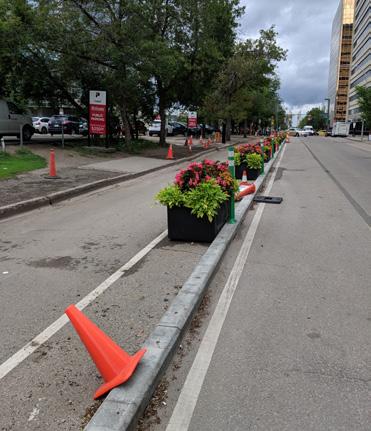
Too narrow to allow for driver’s side door to be opened all the way.
Too short to allow for a rear entry lift to be lowered and a wheelchair to exit.
Too far from the EPark payment terminal.
Curb cut absent or too far away (e.g. at end of block only).
Part of stall physically obstructed by environmental barriers such as construction signs, flower planters, bike lanes, street furniture, or snow windrows.
Sidewalk next to stall physically obstructed by environmental barriers such as local shop signs/sandwich boards, construction signs, flower planters, bike lane curbs, or snow windrows preventing passenger side door from opening all the way or a side entry lift from lowering down.
Feedback Regarding Accessible Curbside Designated Parking Stalls Placard Holders we spoke to expressed that designated stalls often enabled them to park and exit their vehicle more safely and easily. However, they reported frequently finding:
There were not enough designated stalls to meet demand.
Designated stalls were not close enough to or did not include a curb cut to enable access to the sidewalk.
Designated stalls did not exist in all the places they needed to go.
“I’m always thinking to myself where can I park...where can I get my lift out?” (In-context Interview participant)
Cost/Affordability is a Barrier for Some Users Cost is a barrier to parking for some Parking Placard holders we spoke to, particularly those who live on a fixed income (e.g. seniors accessing CPP, individuals accessing AISH). Some Parking Placard holders we spoke to felt that if they had to start paying for parking that it would prevent them from going places where they had to park curbside and pay. Additionally, people discussed having to park at higher frequency in places that require payment (e.g. hospitals).
“Having a disability is harder because of the built environment - if we can alleviate some of the stress associated with inaccessible built environments then why wouldn’t we?” (In-context Interview Participant)
“I’m all for sliding scale payment options….I think people should be allowed the dignity of paying what they can pay...with minimal proving of income” (In-context Interview Participant)
Feedback from Transportation Providers Transportation providers such as Driving Miss Daisy are an important stakeholder in this challenge. We spoke to one transportation provider as part of the design research process and they communicated how changes to the current parking subsidy that allows Parking Placard holders to park for free for up to two hours would negatively impact their business.

Most customers of these services are seniors and rely on the service due to its convenience and affordability. The transportation provider’s priority is to be able to get as close to the doors of their destination as possible due to the limited mobility of their customer, who is typically unable to use DATS and cannot rely on taxi transportation due to the additional support they require in getting to and from the door. The service provided by these providers consists of parking as close to the doors of the destination as possible, aiding the customer out of the vehicle and into the destination, and then returning to the vehicle and departing. Pick-up is much the same process. The majority of parking periods are in the 10-15 minute range, with occasional longer waits.
To transfer in and out of her car this Feedback received from transportation providers suggested that the participant needs to open her door all use of designated accessible stalls is often not the best option, with the way often into oncoming traffic. She relies on drivers noticing her and EPark stalls typically providing access that is closer to the destination moving over. Her transfer takes several minutes due to stiff, sore joints. or entry door. In some cases, there are passenger and commercial loading stalls available, and the vehicles in the providers’ fleets often do have commercial plates, so these can be used when available, but the volume of available commercial zones doesn’t align with the needs of the customers. In many cases, transportation providers such as Driving Miss Daisy are using the Parking Placards to facilitate pick-ups and drop-offs of their customers in paid curbside EPark zones.
If a requirement to pay was imposed on these transportation providers, the impact to the service would be noticeable in the following ways:
Increased time for the completion of the transportation service, because drivers would need to handle payment.
Increased cost burden to the business that would be passed on to customers, most of whom are operating on a limited fixed income.
Mapping Placard Holder Parking Experiences The accompanying document titled “Mapping Placard Holder Parking Experiences” summarizes the parking journey, including pain points and opportunity areas, of five Parking Placard holders who participated in in-context interviews. This illustration reflects both the complexity of the challenge and the fact that no two experiences are exactly alike.
City of Edmonton Stakeholder Workshop The Internal Stakeholders Workshop took place at the Skills Society Action Lab - convened by Skills Society Action Lab, Lift Interactive, and The City of Edmonton. This workshop brought together key stakeholders who work within The City of Edmonton and are responsible for the delivery of parking services to Parking Placard holders.
Through participation in group discussions as well as a journey mapping exercise, participants had the opportunity to both surface and explore assumptions about the experience of curbside parking in Edmonton for Parking Placard holders. The goal of the workshop was to:
1.
2. Learn from City of Edmonton what their staff perspectives were related to the challenge area
Align and educate on the research approach - Human-Centred and Inclusive Design principles, and manage expectations related to the final project findings.
3. Surface assumptions, hopes, and considerations for the remainder of the project.
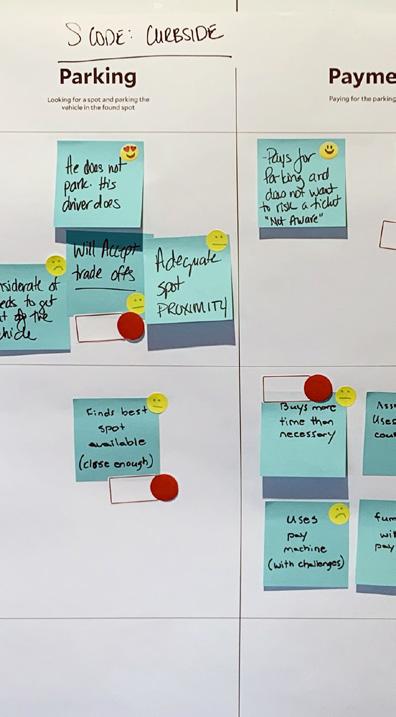
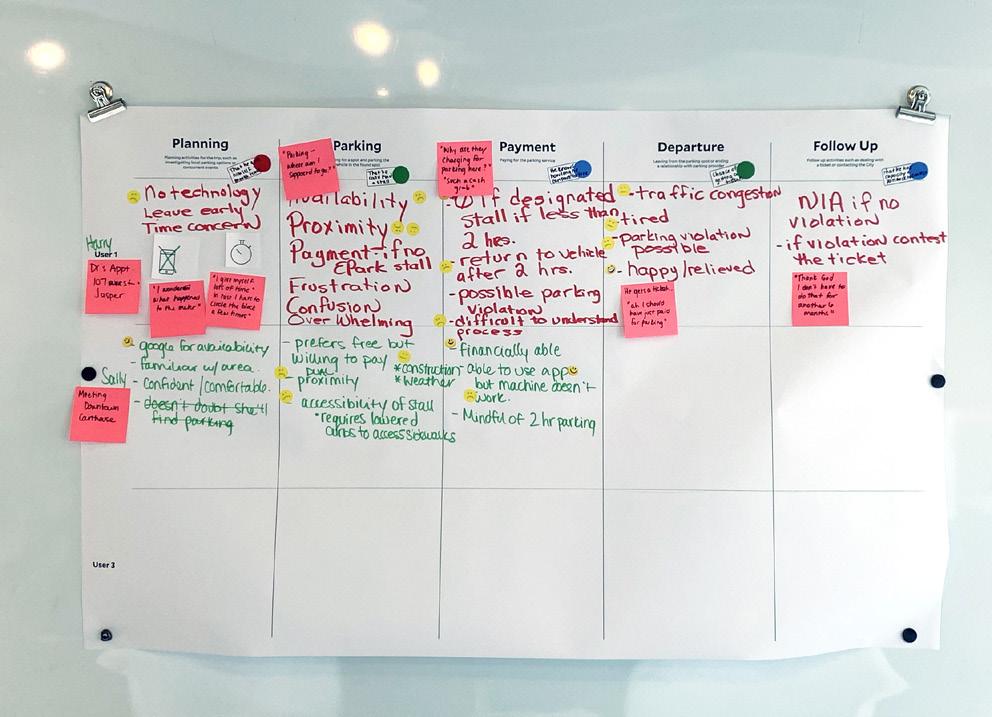
Workshop participants surfacing and exploring assumptions about curbside parking experiences in EPark zones, and mapping out the parking journey of an Accessible Parking Placard holder.
SUMMARY OF KEY FINDINGS
What’s working well in the context of the current Gratuity Program and EPark parking programs at the City? • Manual Enforcement: In many ways, key stakeholders felt that the current status quo, manual enforcement of parking is working well. They discussed five customer-experience focused checks officers use in determining exemption need.
Exemptions for Other Groups Have been Phased Out: Stakeholders discussed how parking exemptions for other groups (e.g. veterans) have been slowly phased out. The general sentiment of stakeholders in the workshop was that ‘everyone should pay to stay’. Stakeholders discussed some of the tensions that arise related to determining who receives an exemption and who does not.
What’s not working well in the context of the current Gratuity Program and EPark parking programs at the city? • Lack of Data: Limited data related to Parking Placard holder’s parking stays makes tracking how much and where Parking Placard holders are using the system (i.e. volume, location, patterns of usage) difficult and challenging to legitimize efficacy of the program. There is also uncertainty around how many tickets are being issued to placard holders in error.
No Checks & Balances for Placard Abuse: There is limited ability and resources for municipal enforcement of fraudulent passes or abuse of use (e.g. individuals using placards that belong to someone else).
Misinformation/Unclear Communication: Externally there continues to be confusion about the Gratuity Program amongst Placard holders as well as about proper placard usage itself. Information is not readily available to the public (i.e. online and otherwise). Internally there are also inconsistencies in understanding of specifics related to the parking program and a lack of documentation related to the origins of the Gratuity Program.
No Policy re Exemptions: There is no current City of Edmonton policy related to whether Parking Placard holders should receive exempted parking. The gratuity program continues to operate on historic rules of unknown origin. The Gratuity Program is also not extended to additional groups such as verified low income earners, AISH recipients etc.
Poor Accessibility of Current Curbside Zones: Existing curbside paid EPark zones, as well as curbside designated accessible stalls often do not meet Access Design guidelines, and retrofitting is difficult and costly (often times impossible due to road and sidewalk width).
Co-Design Workshop with Placard Holders On the evening of July 17, 2019, Parking Placard holders and their supports gathered in the Skills Society Action Lab to participate in a co-design workshop. Invitations to participate went out to all Placard holders who had expressed interest in the project when Parking Placard holders were first surveyed by The City in 2018, as well as participants in the telephone and contextual interviews, members of the Accessibility Advisory Committee, and people supported by Skills Society.
JOURNEY MAPPING WITH COMMUNITY MEMBERS
Journey Mapping was facilitated to generate input from community members on the pros and cons of possible alternatives to the current way in which Parking Placard holders interact with curbside parking. The following three questions were explored with participants based on their significant impact to the operation of the EPark system, and their effect on Parking Placard holders:
1.
2.
3. Should Parking Placard holders be exempted from paying for parking? What are the implications of this decision? An exploration of whether or not Parking Placard holders should pay for parking in paid curbside EPark zones was undertaken.
How could vehicles with Parking Placards be recognized in the context of the APEP
launch? An exploration of methods for allowing Parking Placard holders to register their license plate(s) was undertaken.
What payment solution(s) could be implemented that would be effective and usable
for any motorist, including those with disabilities? An exploration of current payment methods to uncover known accessibility challenges was undertaken. This information can be used to facilitate easier payment in the future for a broader group of users (if required).
Placard holders exploring the parking journey and providing possible solutions from their perspective.
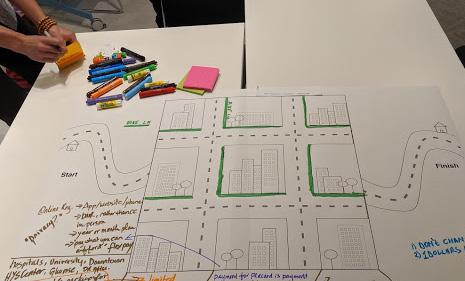

Key Insights Generated from Journey Mapping with Community Members • Many placard holders were not aware of the option for a provincially issued license place that displayed the universal symbol of access
Winter accessibility in Edmonton was highlighted as a significant challenge, not just in parking, but in terms of general mobility as well
There isn’t an expectation of “perfection” from the accessibility community, but looking to see that there is ongoing work to make things better
Participants felt that accessible parking regulations should be managed provincially in order to create a consistent experience in all cities in the province
Some feel there is a lack of clarity around parking duration both in EPark zones and in designated accessible parking locations
Due to specific needs, such as access to curb cuts, the time it takes for a Placard Holder to find a parking spot can be significant
Some felt that the move away from individual meters has made paid parking less accessible


Placard holders exploring the parking journey and providing possible solutions from their perspective.

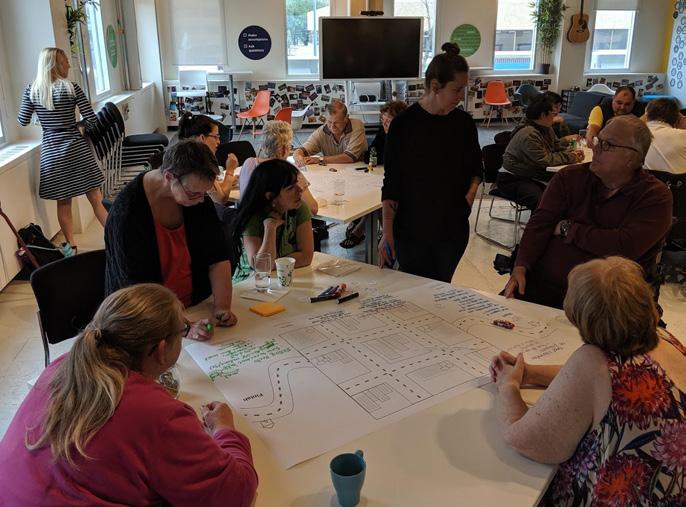
Tech Review
EPARK APP
Though the focus of this project was not to conduct a full user experience and design audit of the MyEPark App., the project team did gather feedback from participants regarding the current usability of the MyEPark App. The following is a basic overview of some of the challenges highlighted by participants related to accessibility and general usability of the MyEPark App.:
Discrepancies in information presented in various areas of the app:
Example: the app claims to provide auto top-up of funds, but states that it doesn’t store credit card information
When starting a session, the MyEPark App. recognizes user location, but when the user presses the “Start Parking Session” button, the zone sometimes changes to 7000 regardless of actual location of the user.
Auto opt in to marketing material in account settings without being presented the option
Map interface used for zone selection is not intuitive, especially given the large “Start Parking Session” button below that leads the user to assume their zone is correct based on location.
Map points are quite small and often tightly grouped, making it challenging from a dexterity perspective.
When a zone has not been selected on the map, the user must remember the zone or be in view of a sign in order to correctly input the number. Otherwise, the user may need to exit the vehicle to find a sign, or try to return to the map screen to check the zone numbers presented there.
The purpose of the ‘Park a Friend’ feature is unclear for those looking to pick a static period of time to park for, as opposed to using the ‘start/end’ method. This is particularly poignant for those Parking Placard holders who use their placard across multiple vehicles
Contact numbers on the “Contact Us” page aren’t hyperlinked for direct access to call.
EPARK WEBSITE
The EPark system includes a website that allows users to manage an account for parking, which can also be connected to the MyEPark smartphone App.
Interactions with stakeholders, primarily interview and workshop participants, uncovered that some users were aware that a MyEPark App. was available, however, awareness of the online EPark website was low.
Functionally, the EPark website allows a user to manage their account, however there are several aspects of use that are not intuitive or optimized for a friendly user experience:
Each time a user wants to add funds to their account, they must enter payment information (i.e. payment information is not saved to their account).
Payment is accepted through a secondary URL that is not clearly branded (https://www. beanstream.com/scripts/payment/payment.asp?) which causes some users to feel the process is not safe - it should be noted that the payment page also shows Copyright 2007 - Calgary Parking Authority. The “Cancel Payment/Go Back” button on the page does not function. “ Changes like this make me, as an individual with mobility challenges, feel like I am treated The site is designed to be mobile friendly, but as a second class citizen in my own city.” as a result, the layout on desktop devices is CARSON, EDMONTON CITIZEN lacking and not appropriately friendly for the types of tasks that might be a priority on desktop - including account and parking session management for Parking Placard holders who are unable to use the MyEPark App..
When looking to start or end a session, a user must know the Zone Number they are parking in. This includes sessions which can be “scheduled” as events through the system. Unfortunately, the website does not provide any method for a user to find Zones, and users must search for the EPark map outside of their EPark account in order to do so.
Labeling of scheduled parking and other parking session management tools is not clear. In order to schedule a parking session, the user must go to “More Options” and select the “Online Activation” option from the provided list (which includes Park a Friend, Online Activation, Change Password, and Update Profile). Session management tool options are not titled in self-explanatory ways that allow users to easily identify their functionality.
A more robust UX review of the MyEpark App. and website using Inclusive Service Design principles is warranted based on the findings of this basic tech review. Incorporating Inclusive Service Design principles into a more robust UX review has the potential to improve the EPark App. not just for Parking Placard holders, but for all other users as well (i.e. everyone benefits when something is user friendly).



